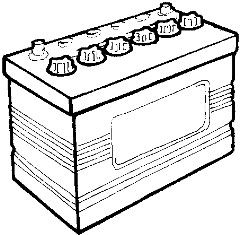Car Battery - Finding the Right Size - Vol.159
So your car battery died and you don't know what to look for when buying a new battery? By following a set of a few basic guidelines you can make sure you get the right battery size for your car.
The most important thing when getting a new battery is to always buy a new one, preferably from a reputable company and always invest in quality as this could save you a lot of trouble down the road. Choosing a new battery might seem like a daunting task with so many different size and specifications, but if you know what you're looking for, you shouldn't have any issues finding the right battery for your car.

Your battery's group size
The first thing you have to look for is the battery's group size. This is the battery's physical dimension and its terminal placement and it's usually a couple of numbers and sometimes a letter (for example newer cars typically use a battery size of 35, while larger vehicles are equipped with a battery size of 65). You will find this information in your car's owner's manual and if you have trouble finding it or you lost the manual, most auto stores that are selling batteries have guides and checking those for your car's make and model will help you determine the battery's group size.
What is your current battery's cold-cranking amps value?
After you determined your car's battery group size, you need to make sure that you are going to purchase a battery powerful enough to power your car in any condition. This is measured in cranking amps and you want to find your battery's cold-cranking amps value (CCA) as this is the battery's power at very low temperatures, when the battery could really struggle to power up the car. This information can usually be found on the battery itself or in the owner's manual and when buying a new battery make sure that its CCA value matches or exceeds your current battery's CCA value. When looking at your current battery you might observe a CA (cranking amps) or HCA (hot-cranking amps), which can be misleading sometimes. It's important when buying a new battery that it's matching your current battery's CCA value as only matching its CA or HCA value might get you a battery that's not powerful enough in certain conditions (for example in low temperatures).
Determining the new battery's reserve capacity and freshness
Another thing you have to look for when buying a new battery is its reserve capacity (RC) which will indicate, in case of an alternator failure (that's the part that keeps recharging your battery), how long can your car run on the battery alone. This information is not usually displayed on the actual battery so make sure you ask the responsible person in the store or check the item's description, if available.
Lastly, you have to make sure that you buy a new battery as batteries, even if they aren't used, will lose some of their charge over time. You should never buy a battery that was produced more than a year before the time of the purchase and it's preferable that it was produced in the last six months. This information should be inscribed on the actual battery, either in plain text or in an alphanumerical code. The code is represented by a letter, followed by a number. The letters represent the month the battery was produced (A is January, B is February, etc.) and the letter "I" is skipped not to be confused with the number 1 so "M" is December. The number represents the year the battery was manufactured (e. g. 1 is 2011) so for example D3 is April 2013.
Following this simple guidelines should help you get the right battery for your car and save you from getting stranded in the middle of nowhere because of an incorrect battery.